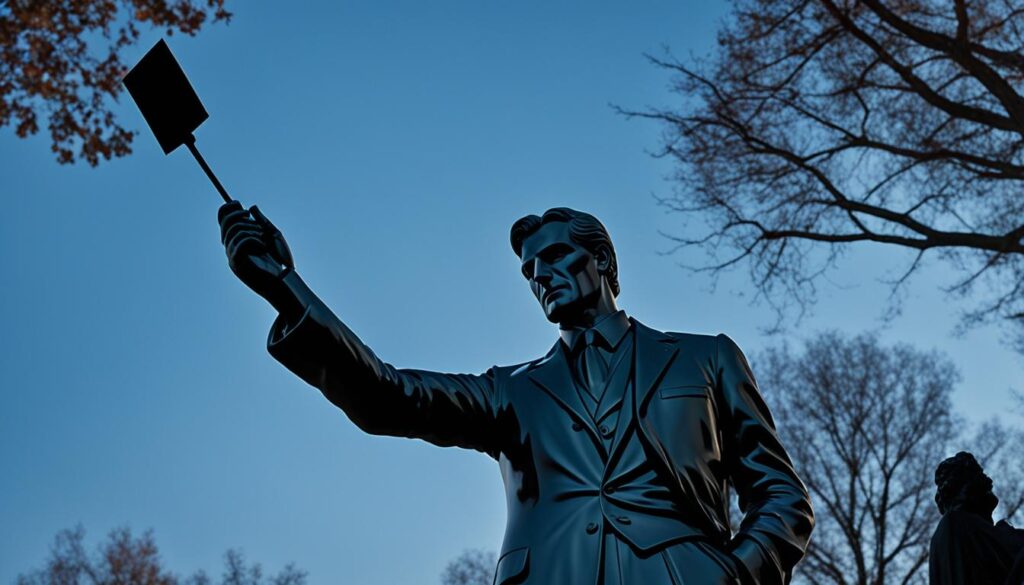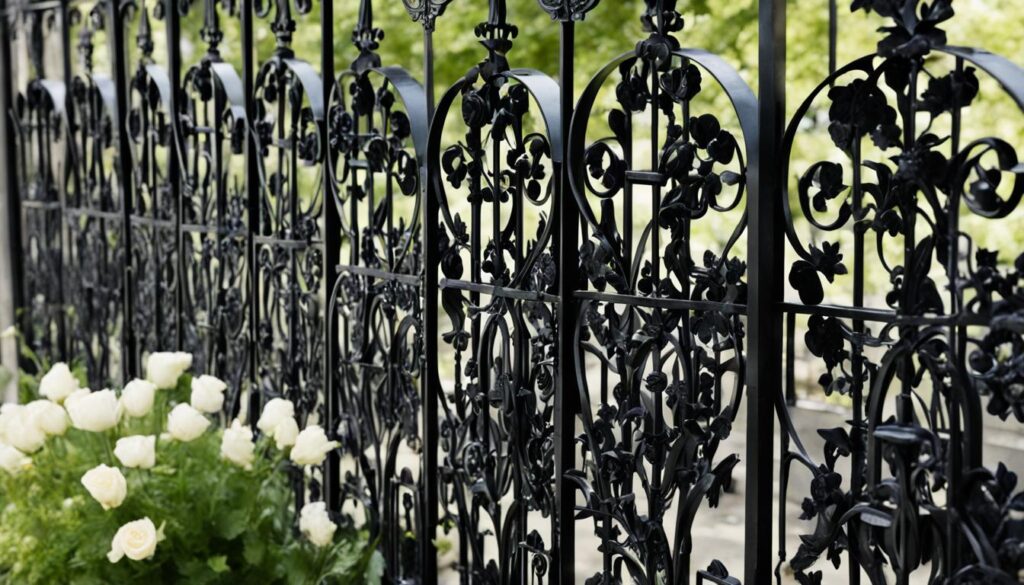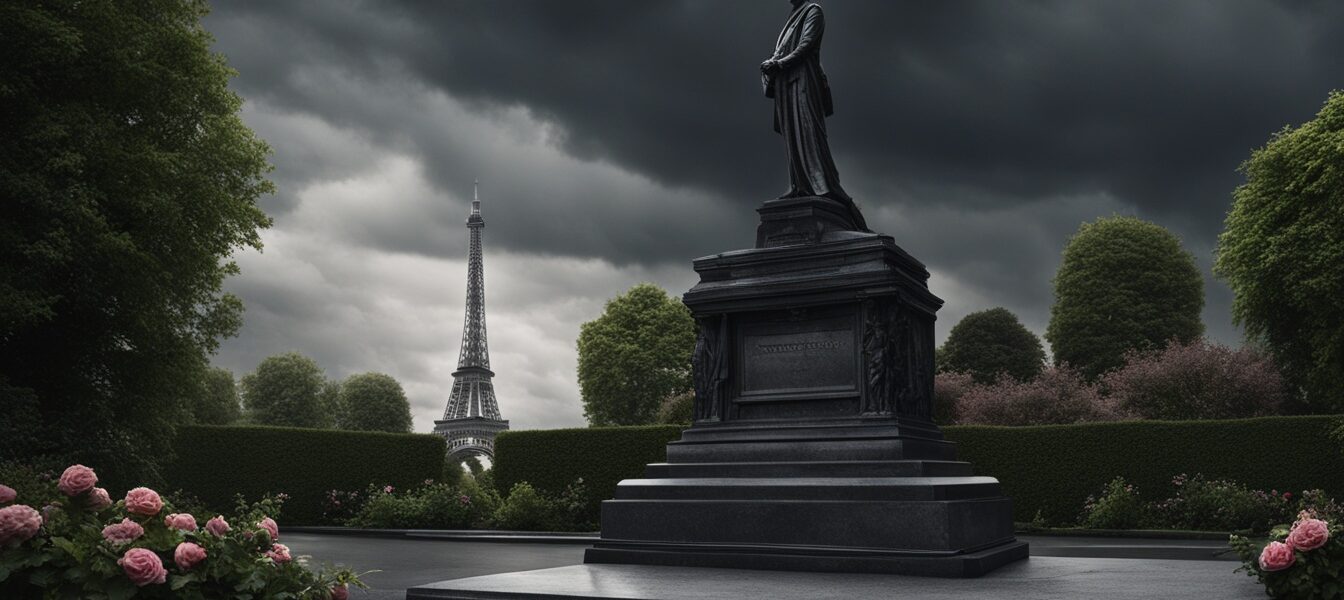Victor Noir’s Grave: A Parisian Legend’s Resting Place
Père Lachaise Cemetery in Paris houses many famous figures’ graves. Yet, Victor Noir’s tomb stands out for unusual reasons. Noir was a young journalist killed by Prince Pierre Bonaparte in the 19th century.
His death sparked outrage and violent protests against the imperial regime. It became a symbol of opposition to Emperor Napoleon III’s rule. However, it was the provocative statue on Noir’s grave that truly made him legendary.
Key Takeaways
- Victor Noir was a 19th-century journalist who was assassinated by Prince Pierre Bonaparte.
- Noir’s death sparked public outrage and violent protests against the imperial regime.
- Noir’s grave in Père Lachaise Cemetery is one of the most visited in Paris.
- A provocative statue of Noir was placed on his grave, further cementing his legendary status.
- Noir’s grave has become a site of pilgrimage, with visitors believing in its ability to enhance fertility.
The Tragic Death of Victor Noir
Victor Noir was a young journalist in 19th-century Paris. He worked for the newspaper La Marseillaise. In December 1869, a dispute between two Corsican newspapers sparked a controversy.
Noir’s Involvement in a Political Dispute
La Marseillaise’s editor accepted a duel challenge from Prince Pierre Bonaparte. The challenge stemmed from a controversial article about the prince’s great-uncle. Noir and another journalist were sent to arrange the duel.
The Fatal Altercation with Prince Pierre Bonaparte
During the meeting, a fight broke out. Prince Bonaparte shot and killed Victor Noir. The murder of a journalist by a royal family member caused public outrage.
“Over 100,000 people attended Victor Noir’s funeral in his hometown Neuilly, France.”
Victor Noir’s death became a symbol of political unrest in France. It sparked public controversy and heated debates. The incident highlighted growing tensions in 19th-century French society.
The Outrage and Funeral Procession
Victor Noir’s death at 21 shocked France. He was killed on January 11, 1870, in Paris by Prince Pierre Bonaparte. This happened just before Noir’s wedding, causing nationwide anger.
Over 100,000 people joined Noir’s funeral procession on January 12th. They marched to a cemetery in Neuilly, his hometown. Republicans saw attending as a civic duty.
Political figures often mentioned their presence at the procession. This was done when endorsing electoral candidates. The huge turnout showed people’s dissatisfaction with the imperial regime.
Up to 200,000 people attended Victor Noir’s funeral procession. This massive crowd reflected the public’s outrage and political activism. It highlighted strong opposition to the ruling Napoleon family.
“The funeral procession of Victor Noir was a powerful display of the people’s defiance against the imperial regime. It was a clear call for change that would ultimately shape the political landscape of France.”
Noir’s death greatly impacted French politics. The public’s reaction and subsequent trials led to major changes. These events ultimately caused the downfall of the Second Republic.
The Trials and Political Aftermath
Victor Noir’s death in 1869 sparked high-profile trials with far-reaching political consequences. The victor noir legal proceedings and victor noir verdicts sent shockwaves through French society. These events shaped the nation’s political landscape.
Rochefort’s Trial and Punishment
Henri Rochefort, editor of La Marseillaise, was found guilty of inciting insurrection. He received a six-month prison sentence and a 3,000-franc fine. Despite this, Rochefort continued running the newspaper and kept his legislative seat.
Pierre Bonaparte’s Trials and Verdicts
The jury accepted victor noir pierre bonaparte‘s self-defense claim, clearing him of murder charges. In the civil suit, the court reduced Pierre’s fine from 100,000 to 25,000 francs, plus legal fees.
The trials were a blow to Pierre Bonaparte. He had embarrassed his family and faced pressure from Emperor victor noir henri rochefort to leave Paris.
Noir’s death highlighted complex political dynamics in France. The trials became a battleground for competing ideologies and power struggles. The victor noir verdicts and victor noir consequences continued to shape French politics for years to come.
The Sculptor Jules Dalou and the Provocative Statue
Victor Noir, a French journalist, was shot dead by Prince Pierre Bonaparte in 1870. Twenty-one years later, sculptor Jules Dalou created a bronze statue to honor Noir’s memory. In 1891, Noir’s body was moved to Paris’s Père Lachaise Cemetery, where Dalou’s striking sculpture now stands.
Dalou portrayed Noir at his moment of death, lying flat on the ground. The statue features a prominent bulge in Noir’s trousers, which later sparked a fertility myth. This detail would make the victor noir statue famous for reasons beyond its artistic merit.
| Key Facts | Details |
|---|---|
| Victor Noir’s Lifespan | 1848 – 1870 |
| Funeral Attendance | Over 100,000 people |
| Relocation to Père Lachaise | 1891 |
| Victor Noir Sculpture Creator | French sculptor Jules Dalou |
| Sculpture Completion | 1891 |
| Sculpture Description | Noir depicted at the moment of his death, with a prominent bulge in his trousers |
Dalou’s bold portrayal of Noir has turned the victor noir bronze into a fertility symbol. The statue’s unique feature has made it a popular spot for women hoping to boost their reproductive chances.
The victor noir monument and its myths have captured public imagination. It has cemented Noir’s legendary status and showcased Dalou’s remarkable artistic skill.
The Bizarre Fertility Myth
Dalou’s statue of Victor Noir has sparked an unusual fertility myth. The statue’s prominent bulge has led to a strange belief. Women hope for fertility, a handsome partner, or twins through a specific ritual.
The Legend of Enhancing Fertility
This myth has made the statue’s groin and shoes shiny from frequent touching. The victor noir fertility legend attracts many visitors to Noir’s grave. Women perform the victor noir fertility ritual, leaving flowers and offerings.
The Ritual at Victor Noir’s Grave
In 2004, officials erected a fence to stop the victor noir fertility superstition. However, protests from Parisian women led to its removal. The myth continues to fascinate visitors seeking love, fertility, or marriage.
“The legend states that if a woman kisses Noir’s lips, rubs the bulge in his trousers, and drops a flower in his hat, she will be blessed with fertility, a beautiful lover, or twins.”
The Shiny Evidence of the Myth’s Popularity
The Victor Noir’s grave fertility myth is visible in the statue’s shiny parts. His lips, groin, and shoes are more polished than the rest. This shows that visitors actively practice the kissing and rubbing ritual.
The Victor Noir statue is a testament to the legend’s enduring influence. Over 100,000 people attended Noir’s funeral in Neuilly. This highlighted the impact of his death on France’s republican movement.
Moving his corpse to Père Lachaise Cemetery in 1891 recognized it as a place for famous individuals. The Victor Noir grave still attracts visitors, including celebrities like Vivienne Westwood and Dita Von Teese.
In 2004, authorities added a warning sign against damaging the tomb. This shows concern over the grave’s maintenance and public behavior. The statue’s worn appearance proves the myth’s power and believers’ dedication.
Despite attempts to restrict access, public backlash led to the fence’s removal. Visitors can now continue their rituals and honor this Parisian legend.

| Statistic | Value |
|---|---|
| Attendees at Victor Noir’s Funeral | Over 100,000 people |
| Year of Prussian Invasion of France | 1870 |
| Year Victor Noir’s Body Moved to Père Lachaise Cemetery | 1891 |
| Year Fence Placed Around Victor Noir’s Statue | 2004 |
victor noir grave
Victor Noir’s grave in Paris’s Père Lachaise Cemetery has become a legendary site. It attracts over 3.5 million visitors yearly from around the world. Noir, a 19th-century French journalist, was tragically assassinated in 1869 during a political dispute.
Sculptor Jules Dalou created a life-size bronze statue depicting Noir lying on the ground. The statue features a prominent bulge in Noir’s trousers, sparking a curious fertility myth. Despite efforts to protect it, the statue’s groin, lips, and shoes remain shiny from constant touching.
Visitors believe touching Noir’s right foot brings good luck and fertility. Touching his left foot is thought to bless people with twins. Grateful women often return to leave offerings at the memorial after becoming pregnant.
In 2004, authorities tried to protect the monument with a fence. However, determined visitors quickly tore it down. The enduring fascination with Victor Noir’s grave continues to captivate visitors today.
The Attempted Fencing and Protests
In 2004, a fence was built around the iconic victor noir statue. It aimed to protect it from constant “indecent rubbing” by visitors. This decision sparked outrage, especially from Parisian women led by TV anchor Péri Cochin.
Authorities soon realized they couldn’t curb public fascination with the victor noir statue. The fence was quickly removed, acknowledging the statue’s cultural importance. This showed the public’s strong desire to engage with the legend.
The victor noir statue remains a source of intrigue for visitors. People continue to seek out the statue for its fertility ritual. Preserving this landmark while allowing public interaction is an ongoing challenge.
| Statistic | Value |
|---|---|
| Le Cimetière du Pere Lachaise contains the graves of over 800,000 Parisiens. | 800,000 |
| The most visited tombs in Pere Lachaise include those of Frederic Chopin, Jim Morrison, Edith Piaf, and Oscar Wilde. | 4 |
| The cemetery has 85 most visited tombs and 23 most visited memorials. | 108 |
| There are monuments in Pere Lachaise dedicated to victims of the Nazis at Auschwitz, Bergen-Belsen, Mauthausen, and others. | 4 |

The victor noir statue has become a must-visit spot in Paris. Attempts to protect it have faced strong opposition. This highlights the statue’s lasting appeal and cultural importance as a unique Parisian landmark.
Visiting Victor Noir’s Grave Today
Victor Noir’s grave in Paris’s Père Lachaise Cemetery fascinates people worldwide. It’s become a shrine for those seeking fertility blessings. Visitors pay respects and take part in unique rituals linked to Noir’s legacy.
Offerings and Gratitude at the Grave
Women who believe the myth helped them often return with special gifts. They leave photos of their children or other items to show thanks.
The statue’s shiny areas, like the groin, lips, and shoes, show how popular it is. This wear reflects the strong belief in the legend of Victor Noir’s resting place.
| Key Statistic | Value |
|---|---|
| Victor Noir’s Lifespan | 27 July 1848 to 11 January 1870 |
| Funeral Procession Attendees | Over 100,000 people |
| Annual Visitors to Père Lachaise Cemetery | 3 million |
Victor Noir’s grave keeps drawing visitors who want to honor his memory. They come to experience the fascinating fertility myth tied to this special resting place.
Conclusion
Victor Noir’s grave in Père Lachaise Cemetery tells a captivating story. It blends tragedy, politics, and fertility legends. Noir’s death by Prince Bonaparte’s hand sparked outrage against the imperial regime.
Dalou’s provocative statue turned Noir’s grave into a legendary site. The myth of enhanced fertility through rubbing the statue’s genital area gained worldwide popularity. Visitors still flock to participate in this unusual ritual.
Noir’s resting place shows the power of legends and superstition. It reflects changing societal values over time. The tomb’s transition from political symbol to sexual icon is remarkable.
Media attention and tourism have boosted the grave’s mystique. It’s now a must-visit spot in Paris. The site showcases Père Lachaise Cemetery’s rich history and cultural significance.
FAQ
Who was Victor Noir?
Victor Noir was a young journalist in 19th-century Paris. He worked for La Marseillaise newspaper. Noir’s death by Prince Pierre Bonaparte sparked outrage against the imperial regime.
What happened to Victor Noir?
In December 1869, Noir went to arrange a duel between two newspaper editors. During the meeting, Prince Bonaparte shot and killed Noir. This incident stemmed from a dispute between Corsican newspapers.
How did the public react to Victor Noir’s death?
The public was outraged by Noir’s murder. Over 100,000 people attended his funeral procession. This event highlighted the growing dissatisfaction with the imperial regime.
What happened in the trials following Victor Noir’s death?
Prince Bonaparte was cleared of murder, claiming self-defense. In a civil suit, the court reduced the fine against Pierre. The initial fine of 100,000 francs was lowered to 25,000 francs.
What is the significance of the statue on Victor Noir’s grave?
Sculptor Jules Dalou created a bronze statue for Noir’s grave. The statue depicts Noir at his death moment. It features a noticeable bulge in Noir’s trousers, which sparked a fertility myth.
What is the fertility myth associated with Victor Noir’s grave?
The statue’s provocative nature sparked a bizarre fertility myth. People believe rubbing the statue’s genital area brings fertility and love. This practice has made the statue’s groin and shoes shiny over time.
How have people reacted to attempts to protect the statue from being touched?
In 2004, a fence was built around Noir’s statue. This decision sparked protests, especially from Parisian women. The fence was soon removed due to public outcry.
How do people continue to visit and interact with Victor Noir’s grave today?
Visitors still flock to Noir’s grave in Père Lachaise Cemetery. Many participate in fertility rituals. Some leave photos or offerings as thanks for fulfilled wishes.
